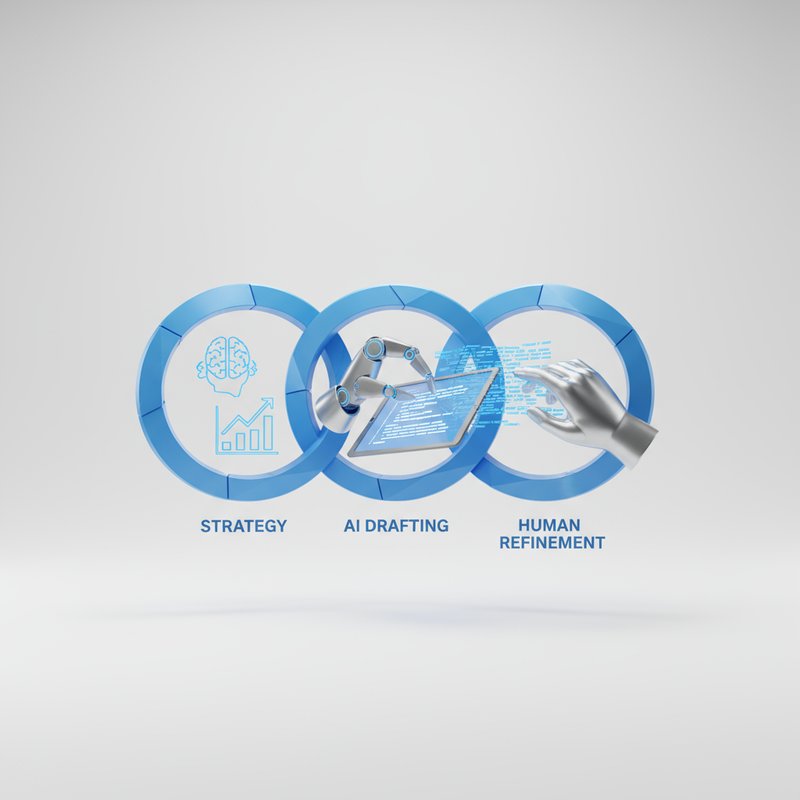Scaling Client Content AI SEO Agency: The Hybrid Blueprint
Scale your SEO agency's content with AI while ensuring quality & E-E-A-T. Discover our Hybrid Blueprint for confident, profitable growth. Get the guide now!
AI for Content Scaling: The Definitive 2025+ Hybrid Agency Blueprint

The Future of Content: A Human-AI Hybrid
Table of Contents
- Introduction
- Beyond the Hype: The Evolution from AI Content to AI-Assisted Strategy
- The Hybrid Agency Blueprint: A Framework for Quality at Scale
- Implementing the Blueprint: A Practical Toolkit for 2025
- Quality, E-E-A-T, and Risk Mitigation: Your AI Content Quality Checklist
- The Hybrid Blueprint in Action: An SEOfast Case Study
- The Future of AI in SEO Agencies: Expert Predictions for 2026 and Beyond
- Conclusion
- Frequently Asked Questions (FAQ)
Introduction
A recent 2025 marketing report revealed a striking paradox: while over 80% of SEO agencies have adopted AI to increase content output, a staggering 70% cite quality control and brand dilution as their single biggest challenge. This is the core dilemma facing modern agencies: the relentless pressure for AI for content scaling clashes with the fear of producing generic, soulless content that damages client trust and search rankings. As part of our comprehensive guide to Link to Hub: Streamlined AI SEO Workflows, this article tackles that challenge head-on.
The debate over "AI vs. Humans" is a false choice. The true path to sustainable growth lies in synergy. That's why we developed the Hybrid Agency Blueprint—a proprietary framework that transforms AI from a risky replacement into a powerful assistant. This model embeds human expertise at critical stages, ensuring that you gain massive efficiencies without sacrificing the strategy, E-E-A-T, and unique brand voice that clients pay for. This guide provides the step-by-step blueprint, a curated toolkit, and a risk-mitigation checklist to help your agency scale content with confidence and quality.
Beyond the Hype: The Evolution from AI Content to AI-Assisted Strategy
To understand where we are, we must first appreciate how we got here. The role of AI in SEO hasn't been a single event but a gradual evolution. For an AI SEO agency for small business or a large enterprise alike, mastering the current landscape means moving beyond simple text generation to embrace a more sophisticated, strategy-led integration of AI.
The Three Waves of AI in SEO
- Wave One: The Age of Automation (Early 2010s - 2020): This era was defined by rudimentary tools like content spinners and basic GPT-2 models. The focus was purely on automation, often leading to low-quality, spammy content that Google quickly penalized. This wave taught us that automation without strategy is a liability.
- Wave Two: The Generative AI Explosion (2021 - 2024): The public release of advanced models like ChatGPT changed everything. Suddenly, generating coherent, long-form content became accessible to all. This wave democratized AI for content scaling, but it also flooded the web with generic content lacking real expertise or originality.
- Wave Three: The Strategic Integration (2025+): We are now in the third wave, defined by integrated workflows and brand specialization. This is the maturity model where AI is not the creator but a co-pilot in a human-led process. Success in this wave depends on building structured, repeatable systems—the very foundation of the Hybrid Agency Blueprint.
The Hybrid Agency Blueprint: A Framework for Quality at Scale

The Three-Stage Hybrid Agency Blueprint
The Hybrid Agency Blueprint is a three-stage framework designed to maximize AI's efficiency while safeguarding quality. It’s a structured workflow that turns the chaotic potential of AI into a predictable, scalable asset for your agency.
(Imagine a visual infographic here, illustrating the three circular stages: 1. Human-Led Strategy & AI-Powered Research -> 2. AI-Assisted First Draft Generation -> 3. Human Refinement, E-E-A-T, and Optimization)
Stage 1: Human-Led Strategy & AI-Powered Research
This initial stage is grounded in human intellect. A strategist, not an algorithm, defines the campaign goals, target audience, unique brand voice, and overarching content strategy. Once the strategic direction is set, AI is deployed to accelerate research. This is how to find content gaps with AI at scale, transforming a week of manual analysis into an afternoon of focused work. Instead of just using automated keyword research tools to find standalone terms, AI can identify entire topic clusters, analyze competitor content for weaknesses, and even help develop detailed audience personas based on provided data.
Example Prompt for Persona Development:
“Act as a marketing strategist. Based on our client’s product (a project management tool for freelancers) and target audience data (freelance graphic designers, writers), generate three detailed user personas. For each, include their primary goals, daily pain points, and the key questions they would type into Google when looking for a solution.”
Stage 2: AI-Assisted First Draft Generation
With a clear strategy and deep research, the next step is generating a first draft. The key here is advanced prompt engineering. A vague prompt like "Write a blog post about SEO" yields a generic, useless article. A detailed prompt, however, produces a structured draft that is 70-80% complete. This is where you leverage specialized brand voice AI tools and refined prompting techniques.
- Bad Prompt: "Write about AI for content scaling."
- Good Prompt: "Write a 1200-word blog post outline titled 'The Hybrid Approach to AI Content Scaling'. The tone should be authoritative yet accessible for SEO agency owners. Start with an introduction that cites a challenge, then create three main sections. The first section should cover AI-powered research, the second AI-assisted drafting, and the third human-led refinement. Include the keywords 'AI for content scaling' and 'content quality at scale'. The draft must include placeholders for expert quotes and a checklist for editors."
Stage 3: Human Refinement, E-E-A-T, and Optimization
This is the most critical stage for achieving content quality at scale. An expert human editor or strategist takes the AI-generated draft and elevates it. This goes far beyond proofreading. It involves fact-checking every claim, weaving in unique brand stories, adding proprietary data or experiences, and ensuring the content aligns with Google's helpful content guidelines, which prioritize people-first content. This human touch is non-negotiable for building authority and trust.
The Human Editor's Checklist:
- Verify Facts: Are all stats, claims, and data points accurate and cited?
- Inject E-E-A-T: Have you added unique insights, expert quotes, or personal experiences?
- Refine Brand Voice: Does the tone match the client’s brand guide perfectly?
- Add Originality: Have you replaced generic examples with specific, proprietary ones?
- Check SEO: Is the content fully optimized for the target keywords and user intent?
This stage is what separates a top-tier AI content quality checklist from a mere grammar check.
Implementing the Blueprint: A Practical Toolkit for 2025
Having the right framework is only half the battle; you also need the right tools. Here is a curated list of the best AI SEO software and platforms, categorized by their function within the Hybrid Agency Blueprint. For a more exhaustive list, check out this excellent review of the best AI SEO tools.
Tools for AI-Powered Research & Strategy
- Clearscope/MarketMuse: These platforms are excellent for in-depth content analysis. They use AI to analyze top-ranking content and provide a comprehensive list of topics, questions, and keywords to include in your article, making them powerful automated keyword research tools for building authority.
- SEMrush/Ahrefs: Beyond their traditional SEO capabilities, these platforms have integrated AI features to help identify content gaps, analyze search intent at scale, and cluster keywords thematically.
Tools for AI-Assisted First Drafts & Brand Voice
- Jasper/Copy.ai: Leaders in the generative AI space, these tools offer robust templates and workflows for creating long-form content. Their key advantage for agencies is the ability to create brand voice profiles, allowing you to train the AI on a client’s specific tone and style, which is crucial for scaling content production for agencies across multiple clients.
- Writer.com: This platform is purpose-built for enterprise and agency use. It allows you to create detailed style guides that the AI uses to ensure every piece of content, from a blog post to a social media update, adheres to brand rules.
Tools for Human Refinement & Optimization
- SurferSEO: A favorite among SEOs, this tool analyzes your draft against top competitors and provides a real-time score for on-page optimization, from keyword density to heading structure.
- Grammarly/ProWritingAid: These AI-powered writing assistants are essential for the refinement stage, catching grammatical errors, suggesting stylistic improvements, and ensuring readability.
- Copyscape: An absolute must in any AI workflow. Use it to ensure the AI-generated content is original and not unintentionally plagiarized from existing sources.
Quality, E-E-A-T, and Risk Mitigation: Your AI Content Quality Checklist

Ensuring Quality in AI-Generated Content
Let's address the primary fear: the risk of being penalized for using AI. This section provides a clear guide to managing that risk effectively.
Does Google Penalize AI Content? The Official Stance
So, Does Google penalize AI content? The short answer is no. Google has been clear that its policies prohibit low-quality, spammy content, not AI-generated content itself. Their focus is on whether the content is helpful, reliable, and created for people. The risk isn't the tool; it's how you use it. Low-quality, unedited AI content created to manipulate rankings will be penalized. High-quality, human-refined content that serves the user—produced with AI assistance—is perfectly acceptable.
The AI Content Quality Checklist
To ensure every piece of content meets the highest standards, use this audit checklist before publishing. This is the core of your quality assurance for content quality at scale.
1. Factual Accuracy & E-E-A-T:
- Have all factual claims, statistics, and data points been verified against a primary source?
- Is the author clearly identified (if applicable)?
- Does the content demonstrate first-hand experience or deep knowledge?
- Have you included quotes or insights from subject matter experts?
2. Brand Voice & Tone:
- Does the article’s tone (e.g., formal, conversational, witty) match the client’s brand guide?
- Are specific brand terminologies and messaging points used correctly?
- Does the content avoid generic phrasing and reflect the brand’s unique perspective?
3. Originality & Plagiarism:
- Has the content passed a plagiarism check (e.g., Copyscape)?
- Are all ideas and examples original, or are they rehashed from the top 10 search results?
- Does the article provide a unique angle or value not found elsewhere?
4. SEO Optimization:
- Is the primary keyword used in the title, H1, and introduction?
- Are secondary keywords and semantic terms distributed naturally?
- Are images optimized with alt text, and are internal links included where relevant?
5. Readability & Human Touch:
- Has the content been edited for flow, clarity, and conciseness?
- Are there personal anecdotes, stories, or relatable examples?
- Does the introduction hook the reader, and does the conclusion provide a clear takeaway?
The Hybrid Blueprint in Action: An SEOfast Case Study
To illustrate the power of this framework, consider this real-world example of AI for SEO case studies.
- The Challenge: A B2B SaaS client in the competitive cybersecurity space needed to increase organic leads but struggled with producing high-quality, technical content at a pace that could compete. Their internal team of two writers could only produce four in-depth articles per month, and freelance costs were prohibitive.
- The Solution: We implemented the 3-stage Hybrid Agency Blueprint. The core idea was balancing automation with strategic oversight to augment their expert team, not replace it.
- The Workflow:
- Strategy: Their internal subject matter expert (SME) spent 2 hours per week outlining technical topics and defining the core arguments for each article.
- Drafting: An agency team member used Jasper with a custom-trained brand voice to generate first drafts based on the SME’s detailed outlines. This reduced initial drafting time from 8 hours per article to just 2.
- Refinement: The SME then spent 2-3 hours refining the AI draft, injecting their deep expertise, adding proprietary data, and ensuring technical accuracy. Our SEO team handled the final optimization.
- The Results:
- Content output increased by 300% (from 4 to 12 articles per month) with the same internal team.
- Time-to-publish was reduced by 60%.
- Within six months, the client saw a 25% uplift in organic traffic to the blog and a 15% increase in demo requests attributed to content.
- This workflow allowed a small business to compete on content with much larger players, making it a perfect model for an AI SEO agency for small business.
The Future of AI in SEO Agencies: Expert Predictions for 2026 and Beyond
The Hybrid Blueprint is the key to success today, but what does the future hold for the AI SEO agency? The next frontier is moving from assistance to prediction and personalization.
We anticipate three major trends:
- Hyper-Personalization at Scale: AI will enable the dynamic customization of content for individual users based on their behavior and intent.
- Predictive SEO Analytics: AI tools will move beyond analyzing past performance to predicting which content topics will trend and what keyword shifts are on the horizon.
- Custom-Trained AI Models: Agencies will differentiate themselves by training their own AI models on client data, creating a defensible moat that generic tools cannot replicate.
This is where the Hybrid Blueprint provides a more sustainable path than the fully automated workflows proposed by some platforms. While solutions like those offered by ContentGecko focusing on multi-stage automation pipelines or the mass-production programmatic SEO approach seen from SEO Bot AI are impressive, they risk minimizing the strategic human element that builds long-term authority. The future isn’t about removing humans; it's about giving them superpowers. This is essential for scaling content production for agencies that want to be partners, not just vendors.
Conclusion
For SEO agencies, the challenge of scaling content is immense, but the solution isn't a race to the bottom with full automation. The path to profitable, sustainable growth is the Hybrid Agency Blueprint. It’s a proven framework that marries the incredible efficiency of AI with the irreplaceable value of human strategy, creativity, and expertise.
By following this guide, you now have the strategy (the Blueprint), the tools (the Toolkit), and the safety net (the Quality Checklist) to scale content production confidently. You can increase output, improve profitability, and deliver exceptional results that build client trust and stand the test of time. This approach ensures your work contributes positively to the broader goals detailed in our full guide on Link to Hub: Streamlined AI SEO Workflows.
Ready to implement a scalable content strategy that delivers results? Contact the experts at SEOfast for a free consultation on building your own Hybrid AI Workflow.
Frequently Asked Questions (FAQ)
1. What's the ideal percentage of AI vs. human work in content?
There's no magic number. For a highly technical or thought leadership piece, it might be 30% AI (research, outline) and 70% human (writing, expertise). For a simpler informational article, it might be 70% AI (drafting) and 30% human (editing, fact-checking). The key is to always have the final 100% of quality control be human.
2. Can AI really match a complex brand voice?
Out of the box, no. But with today’s brand voice AI tools and proper training, it can get remarkably close. By feeding the AI your client’s style guide, existing content, and specific tonal instructions in your prompts, you can generate a draft that is a strong starting point for your human editors to refine.
3. How do you find and train editors for an AI-assisted workflow?
Look for editors who are also strong strategists. They need to be more than just grammar checkers; they must be able to think critically about content, add unique value, and understand SEO principles. Train them on your Hybrid Blueprint, emphasizing that their role is to elevate the content, not just correct it.
4. What are the biggest mistakes agencies make when using AI for content scaling?
The biggest mistake is skipping the human refinement stage (Stage 3). Agencies that try to go straight from AI draft to publishing produce low-quality, generic content that lacks authority, alienates readers, and risks Google penalties. The second mistake is using vague prompts and expecting high-quality output. Garbage in, garbage out.